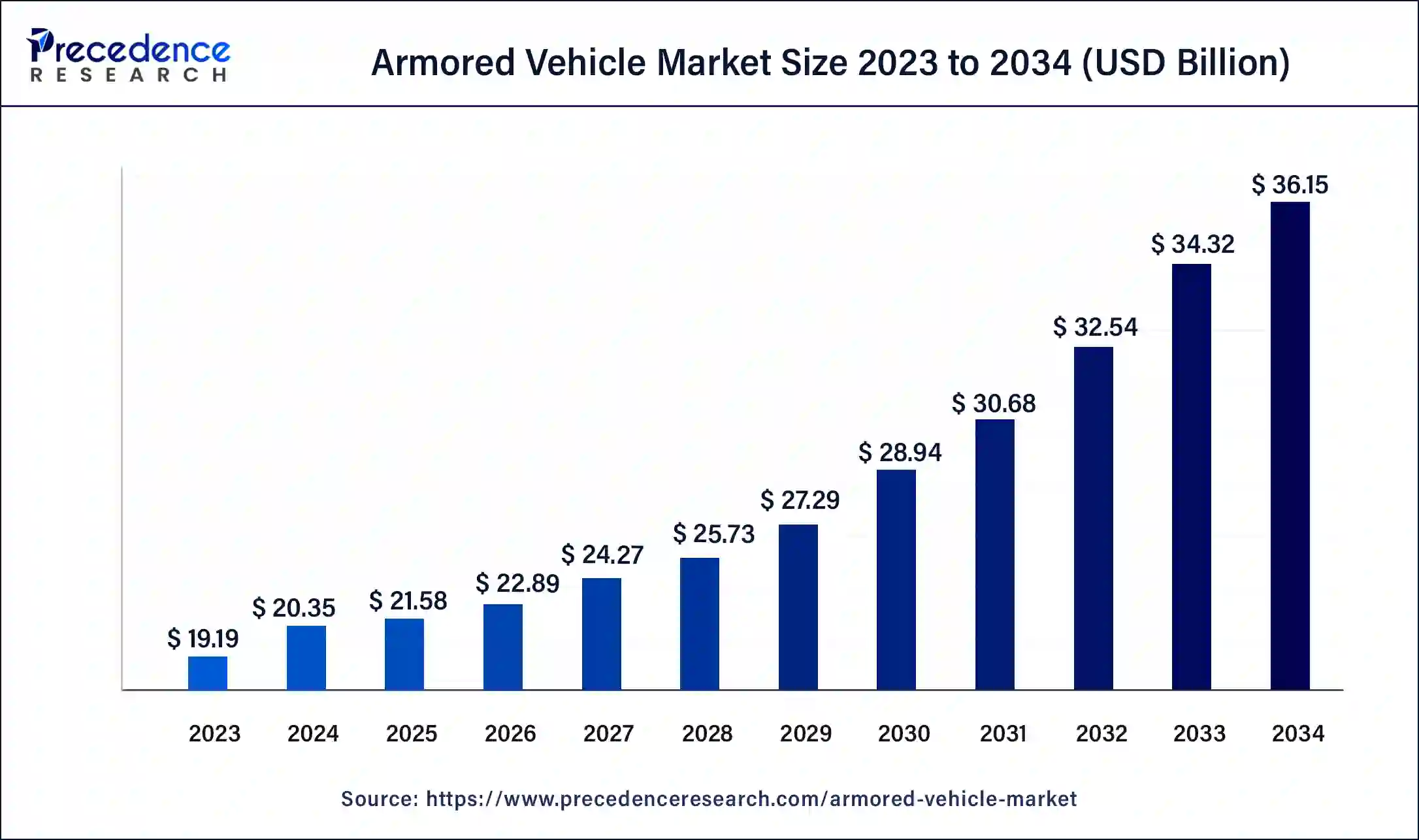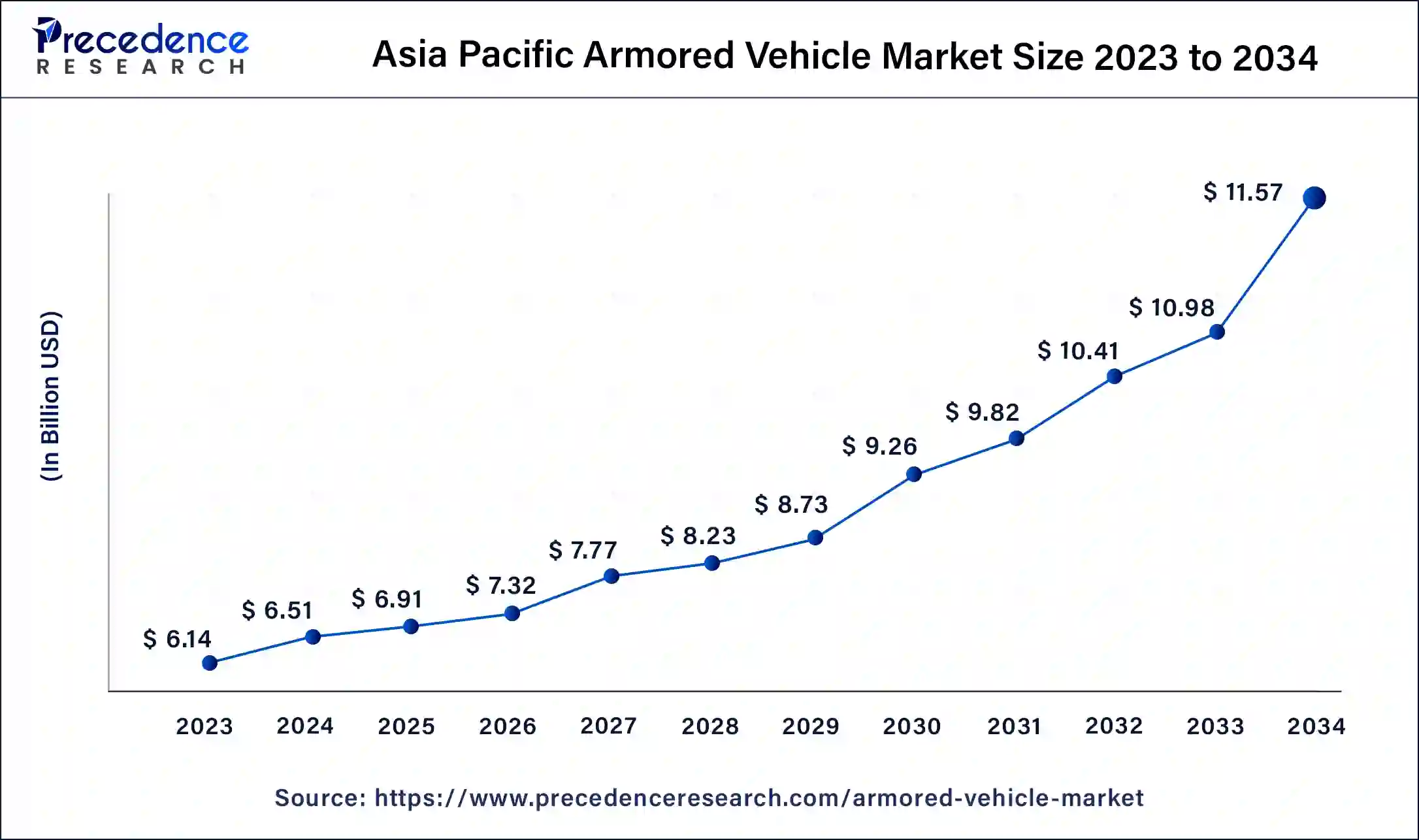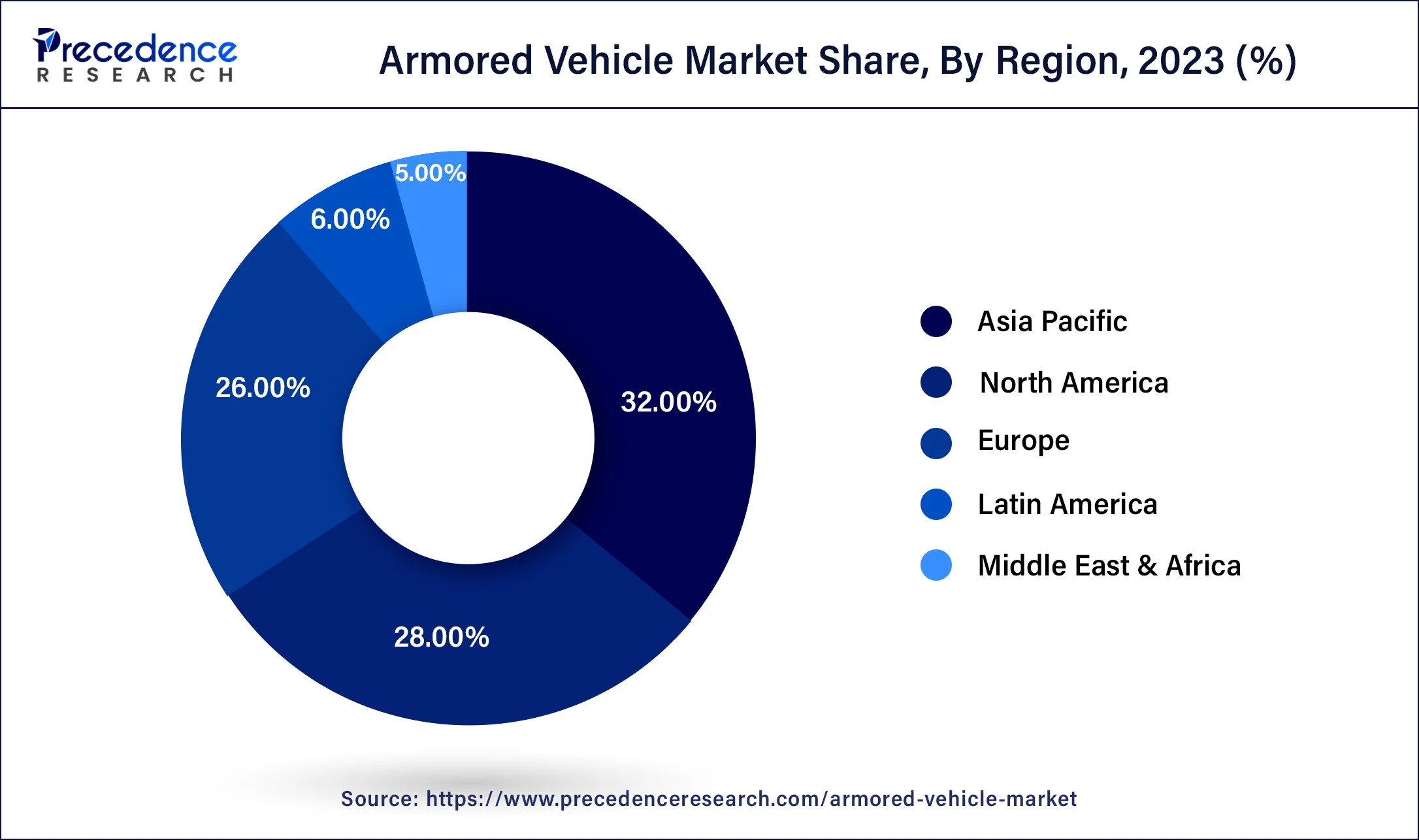November 2024
Armored Vehicle Market (By Platform: Combat Vehicle, Combat Support Vehicle, Unmanned Vehicle; By Application: Defense, Commercial; By Mobility: Wheeled, Tracked; By Sales: OEM, Retrofit) - Global Industry Analysis, Size, Share, Growth, Trends, Regional Outlook, and Forecast 2024-2034
The global armored vehicle market size is calculated at USD 20.35 billion in 2024 and is expected to reach around USD 36.15 billion by 2034, expanding at a CAGR of 5.9% from 2024 to 2034. Increasing demand for bulletproof vehicles is observed to boost the market’s growth during the forecast period.

The Asia Pacific armored vehicle market size is calculated at USD 20.35 billion in 2024 and is expected to reach around USD 36.15 billion by 2034, expanding at a CAGR of 5.9% from 2024 to 2034.

Asia Pacific is expected to dominate the market during the forecast period. The rising spending on the defense sector in India and China is considered to fuel the market’s growth. The demand for new armored vehicles in Asia Pacific is growing on the note of replacing the aging armored vehicles and deploying advanced armored vehicles in the military. Furthermore, the rising capacities of local manufacturing companies in India, China, and Japan are observed to propel the market’s growth.
Along with India and China, Japan's market for armored vehicles is flourishing since the country increased tests for new armored vehicles. For instance, in October 2022, the defense ministry of Japan confirmed that Japan had started trials of locally built armored vehicles.

North America accounts for the largest share of the global armored vehicle market. The presence of major manufacturers in the region and substantial military budgets in the U.S. has supported the market’s growth in North America. Moreover, the U.S. defense ministry is focused on deploying armored electric vehicles for efficient operational capabilities; this factor is observed to boost the market’s growth during the projected period.
Europe is another largest marketplace for armored vehicles. The rising demand for luxurious commercial vehicles in the region is boosting the deployment of armored vehicle parts. The sudden rise in cross-border conflicts is seen as a significant factor in increasing the demand for advanced armored vehicles in the region. Furthermore, rising defense modernization programs in various European countries are boosting the growth of the armored vehicle market.
The armored vehicle market in the Middle East and Africa is expected to grow at a CAGR of 2.5% during the forecast period. The risk of cross-border conflicts has forced the modernization of armored vehicles. The armored vehicle market in Africa shows steady growth. However, emerging economies and increasing military budgets will boost the growth of the armored vehicle market in Africa. The armored vehicle market in Latin America depends on battle tanks' development. Emerging economies in countries such as Brazil, Argentina and Mexico are anticipated to boost Latin America’s market share in upcoming years.
An armored vehicle is an advanced vehicle that provides potential protection against bullets, rifles, and other hazardous projectiles. Such vehicles are designed to fight adverse situations for both commercial and defense users. Armored vehicles enable police officers, soldiers, troops, high-profile personalities, and even civilians in conflict areas to move confidently.
Armored vehicles are widely used in the defense sector as well as within the country’s borders to enhance security and survivability. A typical armored vehicle consists of armed plates, primary weapons, bulletproof glasses, a command system, a navigation system, an engine, a fire control system, an observation system, armaments, frames, and other ballistic materials. Safety escort, protecting dignitaries, and self-defense are major purposes of armored vehicles.
Geopolitical tensions are on the rise in Asia Pacific, Europe, and the Middle East due to shifting relations between countries. On the note of increasing geopolitical tensions between countries, the rising demand for advanced armored vehicles from the defense sector has supplemented the growth of the global armored vehicles market. Factors such as advancements in the defense sector, rising requirements for improved battle intelligence and technological competence are propelling the market’s growth.
Furthermore, multiple European manufacturers are focused on developing uncrewed armored vehicles for the defense sector; this factor highlights the development in the armored vehicle market. However, the high cost of armored tanks and other military vehicles is likely to hinder the market's growth. Moreover, the rising need for monitoring naval and land borders and increasing demand for protective vehicles for government purposes is projected to boost the development of the armored vehicle market.
The production of autonomous vehicles and deployment of robotics in armored vehicles are observed to offer a remarkable shift to the global armored vehicle market.
| Report Coverage | Details |
| Market Size by 2034 | USD 36.15 Billion |
| Market Size in 2023 | USD 19.19 Billion |
| Market Size by 2032 | USD 20.35 Billion |
| Growth Rate from 2024 to 2034 | CAGR of 5.9% |
| Largest Market | Asia Pacific |
| Base Year | 2023 |
| Forecast Period | 2024 to 2034 |
| Segments Covered | Platform, Application, Mobility, Sales, and Region |
| Regions Covered | North America, Europe, Asia-Pacific, Latin America and Middle East & Africa |
Rising demand for VIP security
The rising demand for VIP security in order to protect the lives of diplomats is driving the market for armored vehicles. The survivability and security of politicians, government officials, and other dignitaries have become a significant concern due to rising political tensions within the borders. Armored vehicles are designed to offer outstanding protection along with primary weapons, ballistic glasses, protective plates, armored covering, G.P.S., and siren system.
Armored vehicles are generally known for offering enhanced comfort, privacy, and higher protection than regular cars. The effectiveness provided by armored vehicles for high-profile individuals is increasing the demand for advanced armored vehicles.
Mechanical failures in the armored vehicles
Continuous movement and logistic strain can cause an occurrence of mechanical or electrical failure in the armored vehicle. The failed transmission system, engine breakdown, and jammed components in armored vehicles can result in disruption of operation in adverse situations such as the battlefield. Moreover, such failures often take time to get repaired and restored.
In such cases, the unavailability of supply vehicles may cause a severe hazard to the user. Thus, such mechanical and electrical failures act as restraining factors for the market’s growth. However, the rising number of OEMs that ensure the servicing and guarantee of components to avoid such shortcomings is considered to reduce the occurrence of mechanical failures.
Development of fuel-efficient armored vehicles
The requirement for fuel-efficient armored vehicles due to fluctuating fuel prices is creating many opportunities for companies to grow in the global armored vehicle market. Manufacturers are focusing on the development of hybrid or electric armored vehicles to reduce fuel consumption and enhance performance.
The rising transition to clean energy will increase the demand for electric or hybrid-engine armored vehicles from commercial and defense end-users in the upcoming years. Furthermore, rising government involvement and investment in advanced electric vehicles will support the development of fuel-efficient armored vehicles by offering profit-making opportunities for players. For instance, in October 2022, the U.S. Army announced testing and analyzing electric armored vehicles using General Motors’ Ultium Platform.
Covid-19 Impacts:
The Covid-19 pandemic showed mild effects on the global armored vehicle market. The pandemic’s impacts on the overall defense sector have adversely impacted the armored vehicle market. Factors such as shortage of raw materials, closure of manufacturing units, lack of workforce, and disturbed global economy negatively impacted the initial phase of the lockdown. Moreover, delayed contracts and postponed business activities due to strict restrictions showed adverse effects on the global armored vehicle market.
China is one of the largest distributors of raw materials required in armored vehicles; the outbreak of coronavirus in China disrupted the supply chain and even forced many manufacturing companies to shift their units.
However, the armored vehicle market stood firm due to ongoing contracts related to armored vehicles from the militaries of various countries, including the U.S., India, and many others. Governments are focused on increasing the nation’s security level by deploying advanced armored vehicles in the military, and this factor has helped the market combat the loss during the pandemic. Moreover, the geopolitical tensions between Ukraine and Russia during the same period increased the demand for armored vehicles.
The combat vehicle segment is projected to grow at a CAGR of 2.7% during the forecast period. Combat vehicles are designed for combat operations with operational mobility and defense capabilities. The combat vehicle segment is further segmented into battle tanks, armored personnel carriers, armored amphibious vehicles, lightly protected vehicles, and a self-propelled howitzer. The armored personnel carrier is the most lucrative segment.
Major players in the market, such as General Dynamics Corporation, Oshkosh Defense LLC., Lenco Industries Inc and International Armored Group, have shifted their focus to developing armored personal carriers. Armored personnel carriers are expected to witness a significant advancement in the upcoming years due to rising threats from the air and increasing demand for fuel-efficient armored vehicles from the defense sector.
The combat support vehicles segment holds a significant share of the global armored vehicle market. The combat support vehicles segment is further segmented into armored supply trucks, armored command and control vehicles, bridge-laying tanks, and repair and recovery vehicles. Armored supply trucks have enormous requirements.
The technological advancements in the global armored vehicle market are projected to boost the growth of unmanned armored vehicles. Unmanned armored vehicles are capable of operating during serious situations without an onboard human presence. Considering the future, unmanned armored vehicles will undoubtedly play a vital role in the defense sector. For instance, China has already deployed a research center for advanced unmanned armored vehicles for all manufacturers.
The defense segment is projected to dominate the global armored vehicle market. Rising government spending on the defense sector to boost the military's operational capabilities has boosted the demand for armored vehicles in the defense sector. The ongoing geopolitical tensions between Ukraine and Russia since 2022 have increased the demand for advanced armored vehicles. Armored fighting vehicles, tanks, personnel carriers, and light-protected vehicles for patrol troops are a few standard armored vehicles required in the defense sector. Moreover, the defense sector has an enormous demand for gun trucks which are armored vehicles with the availability of weapons for soldiers on the operation field.
The commercial segment holds a significant share of the market. Commercial armored vehicles are utilized for government officials, high-profile personalities, transportation of valuables, and moving people from conflict areas. The rising demand for armored vehicles for government needs propels the segment’s growth. Commercial armored vehicles range from buses, ambulances, cars, and vans.
The wheeled segment is projected to grow at a CAGR of 3.3% during the forecast period. The wheeled armored vehicles offer better road performance with better fuel economy. The wheeled segment is further segmented into 4x4, 8x8, 10x10 12x12 wheeled vehicles. The rising demand for armored personnel carriers from the defense industry is projected to boost the demand for 8x8 wheeled armored vehicles.
The tracked vehicle segment is expected to witness a significant increase during the forecast period owing to the rising demand for armored fighting vehicles from the defense sector. Tracked armored vehicles offer more excellent traction and thus are considered an ideal fit for operations in the military.
The OEM segment is projected to dominate the armored vehicle market during the forecast period. Governments are focused on offering contracts for armored vehicles to the original equipment manufacturers. OEMs guarantee the quality of vehicle parts, and such parts are only available through the dealership, which boosts the reliability of vehicles. The fierce competition in the market is prone to encourage the involvement of OEMs in the market during the forecast period. Furthermore, the rising retro fitment for turning fuel-based armored vehicles into electric vehicles is fueling the growth of the retrofit segment.
Segments Covered in the Report:
By Platform
By Application
By Mobility
By Sales
By Geography
For inquiries regarding discounts, bulk purchases, or customization requests, please contact us at sales@precedenceresearch.com
No cookie-cutter, only authentic analysis – take the 1st step to become a Precedence Research client
November 2024
January 2025
January 2025
January 2025